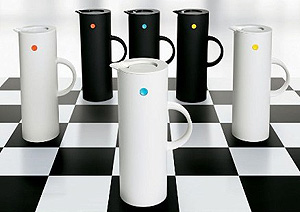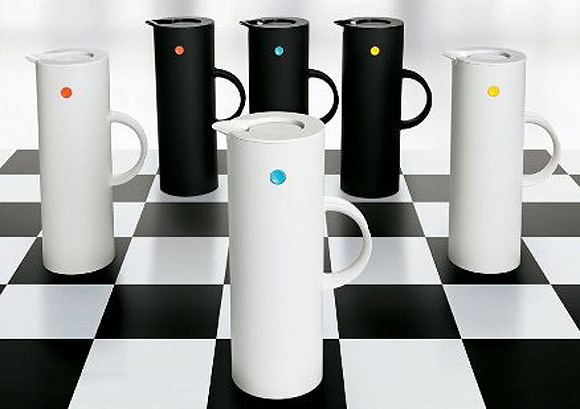
- karsten
A 30-year-old Stelton classic
Stelton’s international bestseller – Erik Magnussen’s classic vacuum jug – completes its 30th year. We celebrate this by presenting six fascinating jubilee jugs: Three soft black jugs, and three soft white ones with the little button in new (never seen before) colours: yellow, orange, and blue. The jugs will be available in shops from June 1, 2007.
A website-special will inform in detail about the history of this classic design-item and Erik Magnussen himself to all interested customers starting at www.30-years.com.
Alongside the planning process for the jubilee jugs, the vacuum jug received on March 29th, 2007, Denmark’s official and most important design prize, The Danish Design Prize 2007. It was handed over to Erik Magnussen and Michael Ring, Majority Shareholder and Managing Director of Stelton, at a glamorous ceremony out of the hands of Denmark’s Crown Prince Frederik. Thus, Stelton’s vacuum jug is the only jug, which received this important recognition twice – when it had its world premier in 1977 and now, 30 years later. A wonderful reason for celebrating the jubilee.

The origins of the vacuum jug
Throughout 30 years and four changing decades, Erik Magnussen’s elegant vacuum jug has been Stelton’s best-selling product. The jug, with its unique rocker stopper, was introduced in 1977 as a follow-up to Arne Jacobsen’s Cylinda-Line jug. The jug is exactly like Arne Jacobsen’s design, and with its taut cylinder shape and two-colour graphic appearance it still expresses a minimalism and a functionality ahead of its time.
Originally, it was made of stainless steel, and since then, it has been produced in around 30 different colours. With its timeless design, the vacuum jug has been popular and stood the test of time through 30 years and four decades of change in culture, social politics and design.
For this, it has received end of March 2007 the official classic design award “The Classics Prize 2007” by the Danish Design Center. This price is Denmark’s official and most important design prize and with this recent distinction, the Stelton vacuum jug is the first and only design product ever, having received this distinction twice – in 1977 in its premier year and after 30 years.
Child of the 70s
When the jug was born, many countries around the world were in the middle of the oil crisis – for the first time (and likely last time), it was possible to go for a walk on high-ways and busy roads, as not one single car was going to drive. The oil crisis bared its teeth in most of the 70s, though the hippie movement, made itself snug indoors with shaggy rugs and pottery in burnt colours. In many European countries, especially the Scandinavian ones including Denmark, the Social Democratic Party was in power, and Marxism was deeply rooted in the minds of the young intellectuals. Political-driven bands, theatres and the “red” temper of the time added colour to life. Visually, the vacuum jug followed suit – and was soon launched in 1970-style colours such as red, brown, and orange. A perfect match for the housing estates and communes of the times.
Young in the 80s
The spirit of solidarities of the 70s soon gave way to the materialistic yuppie mentality of the 80s, and soon the jug found itself in the decade of Narcissism and mirror-clad cafe walls. Postmodernism took over. Fashion was playing with identity and gender. Music was either electronic or mascara-black punk. Architecture was characterized by post-modern eclecticism with its mixed styles, columns, cobalt blue, and pastels. The Conservatives were now in power again and ruling in many countries of Europe the political systems. Then came 1989 and the fall of the Berlin wall – the world opened up, and the Cold War was finally over. The vacuum jug was a highlight in this period with its new pastel-colours as well as half-litre versions.
The Way We Were in the 90s
The 90s is a more spiritual period, the decade that saw the fall of the great ideologies. There is no longer just one truth, and suddenly one thing is as good as another. In culture and architecture, deconstructivism is the order of the day. Money does not count any more; what counts is expressing oneself as a fascinating, unique individual in surroundings all of ones own. An individuality not always compatible with the idea of “Till death us do part”, and so the divorce frequency of the 80s goes up even further in the 90s. The Internet arrives on stage, and IT interferes with everything. Computers invade every home and office. Society changes to a degree and with a speed that no one would think possible. The Internet creates exciting networks and communities across civilizations and frontiers, and global feeling increases accordingly. In parallel to this, the number of colour shades increased with e.g. granite, saffron yellow, and paprika red.
Millennium design
In the course of the 90s and into the new millennium, Erik Magnussen’s vacuum jug blends with both minimalism, retro, Feng Shui, and lounge style. We find it in the homes of traditional families, singles, and new families with children of different marriages, which are becoming more and more common in an age of serial monogamy.
Employment is up in the new millennium, and a cell phone is in every hand. Economy is thriving, and in spite of the collapse of the real estate bubble we are decorating our homes more than ever. TV is packed with interior design programmes. And more than ever before, our homes are used as a setting to show who we are – or how we would like to appear. The Stelton vacuum jug was during this time supplemented with a new, soft-mat and rubber surface and is also offered since 2006 with regular changing as well as limited fashion colours of the season. Colours such as soft black, soft lemon yellow and soft chocolate now replaced some of the earlier colour shades.
In short: Times have changed, politics changed the world, fashion and music styles have been experiencing waves after waves. Yet, like any true classic, Erik Magnussen’s vacuum jug from Stelton has been at the cutting edge of design in every decade. Timeless, a symbol for an iconic statement of design – and front-running because it is continuously and sensitively updated with new colours and materials, without following short-lived trends.
Facts about designer Erik Magnussen
Designer Erik Magnussen (born 1940) was educated as a ceramist at the School of Applied Arts and Design – graduating with a silver medal in 1960. His work is exhibited in museums throughout the world – among others at the Museum of Modern Art in New York. Magnussen has been awarded heaps of prizes through the years. In 1983, he was elected “designer of the year” by the Danish Design Council, and his products have several times been given the ID-prize by the Danish Society of Industrial Design. Most recently, in 1997 Erik Magnussen was awarded “The Red Dot” in the “Design Innovations 1997” competition held by German-based Design Zentrum Nordrhein-Westfalen, and he won the “Good Design Gold Prize” awarded by Japan Industrial Design Promotion Organization.
The Danish Design Prize 2007 goes to’Stelton!
The vacuum jug itself has now won Denmark’s official design prize twice – in 1977 and again in 2007, thus, representing the only product ever winning this design award twice. Again – a distinction only a true icon could ever achieve.
The award ceremony, where Erik Magnussen and Michael Ring, Owner and Managing Director of Stelton, received the price out of the Danish Crown Prince Frederik, took place in the Copenhagen-based Danish Design Center on March 29th, 2007. The accompanying design-prize exhibition is open from March 30th to October 14th, 2007 – more information can be retrieved at www.ddc.dk.
More information about the history of the Stelton vacuum jug, its designer Erik Magnussen as well as the six new, limited jubilee jugs will be available from end of May at www.30-years.com.